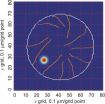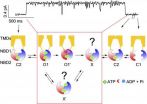(Press-News.org) When will men have their own birth control pill? Scientists have been predicting the debut of a male pill within 5 years for the last 30 years. The factors accounting for that delay — and new optimism that a male pill will emerge within a decade — are the topic of a story in the current edition of Chemical & Engineering News. C&EN is the weekly newsmagazine of the American Chemical Society, the world's largest scientific society.
In the story, Michael M. Torrice, C&EN associate editor, describes the need for a male version of the oral contraceptive pill that revolutionized family planning 50 years ago. For example, there are few choices of contraceptives for men, half of all U.S. pregnancies are unintended, and those pregnancies cost state and federal programs about $11 billion annually.
Despite that need, the few pharmaceutical companies working to develop a male pill have discontinued research during the last five years. The story explains the scientific and regulatory hurdles in developing new contraceptives and describes promising new research on so-called non-hormonal male contraceptives.
### The American Chemical Society is a nonprofit organization chartered by the U.S. Congress. With more than 164,000 members, ACS is the world's largest scientific society and a global leader in providing access to chemistry-related research through its multiple databases, peer-reviewed journals and scientific conferences. Its main offices are in Washington, D.C., and Columbus, Ohio.
To automatically receive news releases from the American Chemical Society, contact newsroom@acs.org
A birth control pill for men? When?
2012-09-26
ELSE PRESS RELEASES FROM THIS DATE:
Loss of species makes nature more sensitive to climate change
2012-09-26
High biodiversity acts as an insurance policy for nature and society alike as it increases the likelihood that at least some species will be sufficiently resilient to sustain important functions such as water purification and crop pollination in a changing environment.
"It's the same principle as an investment portfolio – you'd be mad to put all your eggs in one basket," says researcher Johan Eklöf.
Experiments with eelgrass meadows in shallow inlets on the west coast of Sweden are now showing that climate change can exacerbate the negative effects of losing sensitive ...
Geometry plays a role in GPCR transmembrane signaling
2012-09-26
A recent study in The Journal of General Physiology characterizes the movement of rhodopsin, a GPCR and member of a large family of transmembrane receptors responsible for many cellular responses and involved in many human diseases.
In living Xenopus rod photoreceptor cells, rhodopsin is found in stacks of disc membranes that are difficult to study due to their small size. Now, Peter Calvert (SUNY Upstate Medical University) and colleagues have developed an approach with two-photon microscopy that, for the first time, allows direct examination within the living cell ...
University of Kentucky research sheds light on pain pill abuse
2012-09-26
LEXINGTON, Ky. (Sept. 26, 2012) — A study by a team of University of Kentucky researchers has shed new light on the potential habit-forming properties of the popular pain medication tramadol, in research funded by the National Institute on Drug Abuse. The paper is slated to appear in an upcoming edition of the academic journal Psychopharmacology.
Prescription pain killer abuse is a major public health problem in the U.S. In 2010, more individuals over the age of 12 reported nonmedical use of prescription pain relievers in the past month than use of cocaine, methamphetamine ...
New insights into functionality of cystic fibrosis protein
2012-09-26
CFTR is an important protein that, when mutated, causes the life-threatening genetic disease cystic fibrosis. A study in The Journal of General Physiology (JGP) details how an accidental discovery has provided new understanding about CFTR functionality.
From a scientific standpoint, CFTR is unique in that it is the only known ion channel—a protein pore that enables the passive diffusion of ions across cell membranes—in the enormous superfamily of ABC proteins, which normally operate as active transporters. As active transporters, ABC proteins use energy derived from ...
Paper: Federal law needed to safeguard 'digital afterlives'
2012-09-26
CHAMPAIGN, Ill. – Federal law ought to play a stronger role in regulating social networking sites by allowing users to determine what happens to their "digital afterlives," says a recently published paper by a University of Illinois expert in intellectual property law.
Allowing social networking sites to set their own policies regarding the content associated with the accounts of deceased users does not adequately protect individual and collective interests, especially with people spending an increasing part of their lives online using social networking sites, says Jason ...
Duke Medicine news -- Protein structure unlocks 1 mystery of multi-drug tolerance
2012-09-26
DURHAM, N.C. – The structures of key bacterial proteins have revealed one of the biochemical secrets that enables bacteria to outwit antibiotics.
In a paper published Sept. 20, 2012 in the journal Cell Reports, Duke University School of Medicine researchers and their colleagues describe the results of a series of experiments exploring multi-drug tolerance, a phenomenon that allows bacteria to become dormant and tolerate antibiotics, only to later awaken and re-infect the host. Drug tolerance is a factor in several types of stubborn, recurring infectious diseases caused ...
Taking the battle against the toxic trio beyond 'Leaves of 3, leave it be'
2012-09-26
With more than half of all adults allergic to poison ivy, oak and sumac, scientists are reporting an advance toward an inexpensive spray that could reveal the presence of the rash-causing toxic oil on the skin, clothing, garden tools, and even the family cat or dog. Using the spray, described in ACS' The Journal of Organic Chemistry would enable people to wash off the oil, or avoid further contact, in time to sidestep days of misery.
Rebecca Braslau and colleagues explain that allergic reactions to oils of the toxic trio are more than a nusiance. They claim a huge human ...
Bigger wind turbines make greener electricity
2012-09-26
WASHINGTON, Sept. 26, 2012 — The latest episode in the American Chemical Society's (ACS') award-winning Global Challenges/Chemistry Solutions podcast series concludes that the larger the wind turbine, the greener the electricity it produces. The study could solidify the trend toward construction of gigantic windmills.
Based on a report by Marloes Caduff in ACS' journal Environmental Science & Technology, the new podcast is available without charge at iTunes and from www.acs.org/globalchallenges.
In the new episode, Caduff, a graduate student, and Stefanie Hellweg, ...
Exposure to snot-nosed kids ups severity of cold infections
2012-09-26
Exposure to school-age children raises the odds that a person with lung disease who catches a cold will actually suffer symptoms like a runny nose, sore throat and cough, according to a study just published in the Journal of Clinical Virology.
That finding, the result of a study that drew upon a databank of 1,000 samples of sputum and nasal secretions from people with chronic obstructive pulmonary disease or COPD, comes as a surprise, says Ann Falsey, M.D., professor of Medicine at the University of Rochester and an infectious disease expert at Rochester General Hospital. ...
Buddhist statue, discovered by Nazi expedition, is made of meteorite, new study reveals
2012-09-26
It sounds like an artifact from an Indiana Jones film; a 1,000 year-old ancient Buddhist statue which was first recovered by a Nazi expedition in 1938 has been analysed by scientists and has been found to be carved from a meteorite. The findings, published in Meteoritics and Planetary Science, reveal the priceless statue to be a rare ataxite class of meteorite.
The statue, known as the Iron Man, weighs 10kg and is believed to represent a stylistic hybrid between the Buddhist and pre-Buddhist Bon culture that portrays the god Vaisravana, the Buddhist King of the North, ...


